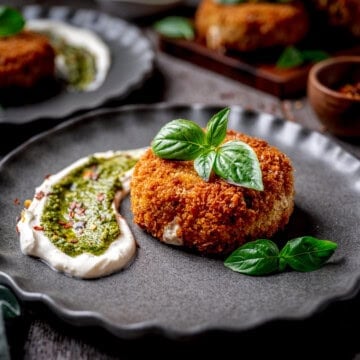Everybody loves a good salad dressing and we are definitely no exception! But store-bought dressings and vinaigrettes just aren’t our thing with all those added preservatives. We love to keep it simple when it comes to salad dressings, and this delicious vinaigrette made with fresh basil and balsamic vinegar is ready in 5 minutes and tastes so vibrant and delicious! We know you will love this basil balsamic vinaigrette recipe!

Looking for another great salad dressing? Check out our Cilantro Ginger Lime Dressing!
Jump to:
Why You'll Love This Recipe
Store-bought salad dressings, although convenient, are generally packed with preservatives, and we prefer to know exactly what is in our food especially for fresh salads.
Salad dressings don't need to be complicated, either. This fresh basil balsamic dressing has simple ingredients and is so quick and easy to make at home.
No need for special equipment! A blender or whisk and small bowl is all you need to make this easy recipe for balsamic vinaigrette salad dressing.
What is a vinaigrette?
At its heart, a vinaigrette is simply an emulsion of oil and vinegar, or any acid in place of or with the vinegar, such as fresh lemon juice. Since oil and vinegar separate immediately, they must be combined by whisking vigorously, or blending so they will emulsify for a period of time. This combination is considered an “unstable” emulsion as the two main ingredients will separate eventually. A "stable" emulsion example would be mayonnaise.
The ratio of oil to acid in a vinaigrette is less important than the flavor, but the classic French version calls for three parts oil to one part acid. Many people consider the norm now to be two parts oil to one part acid in vinaigrettes, but the strength of the acid and the flavor profile you are trying to achieve will dictate your actual preference.
Additionally, nearly anything in reasonable quantities can be added to a vinaigrette for flavor, such as herbs, spices and even fruits. When you see vinaigrettes on the shelf at grocery stores and they aren’t separated, they are kept together with some sort of emulsifier (such as xanthan gum). So a homemade vinaigrette should be made about an hour or less before serving to prevent separation, unless a natural emulsifier is used (such as egg yolk or mustard).
Ingredients
This Fresh Basil Balsamic Vinaigrette is ready in 5 minutes! Here is what you need to make it:
- Neutral Oil: We like a relatively neutral oil, like grapeseed oil, safflower oil or avocado oil, to let the balsamic vinegar and basil shine.
- Balsamic Vinegar: We use the “condiment” style as it is known in Italy, produced in the same way as the thicker aged balsamic vinegar but not aged as long (ours is 7 years vs 12 for the standard). Use a good quality balsamic vinegar for this recipe, nothing too cheap, and make sure it is real balsamic vinegar from Italy for best results.
- White Wine Vinegar: Just a little white wine vinegar will balance the salad dressing and add a touch more acidity.
- Shallot: For a little onion flavor, we like to use a touch of shallot in this vinaigrette.
- Basil: One of the stars of the vinaigrette, fresh basil pairs extremely well with balsamic vinegar.
- Garlic: Just a small amount of fresh garlic for added flavor.
- Kosher Salt
- Black Pepper
- Water: We don’t use much, and it is optional, but it can help to thin the vinaigrette and mellow the flavors some if needed.
See recipe card below for quantities.

Substitutions
Here are a few common substitutions for the ingredients in this vinaigrette recipe:
- Oil: This vinaigrette will feature balsamic vinegar and basil, but if you substitute a good extra virgin olive oil, the oil can play a prominent role in the flavor of the vinaigrette
- White Wine Vinegar: Any vinegar can be used in place of the white wine vinegar, just be wary of how acidic it is. Red wine vinegar, champagne vinegar, or rice vinegar are good alternatives.
- Fresh Basil: While the flavor will be substantially less “fresh,” you can substitute dried basil for the fresh basil in this recipe. We recommend letting it soak in the vinegars for a while before making the dressing to enhance the flavor.
- Shallot: You can use a sweet yellow onion in place of shallot, but try to avoid red onion or more assertive white onions in this recipe.
How to Make Fresh Basil Balsamic Vinaigrette
The easiest way to make a vinaigrette is with a blender. A stick or immersion blender works best for smaller batches and if you’re serving a crowd, a conventional blender is perfect. This will emulsify the vinaigrette quickly and effortlessly, while also chopping up the solids even more. This really is an easy, 5-minute recipe!
Equipment
Only one thing is really needed:
- A blender. Either an immersion blender or a conventional blender will do. Even a food processor will work. If you don't have any of these, you can use a hand mixer. For the old-fashioned way, just use a whisk, it will work and work you out a little as well!
Step-by-Step Instructions
Step 1: Prepare and measure
- Measure out all of the ingredients, chop the basil, and mince the shallot and garlic. It makes preparation of the vinaigrette much easier if you pre-measure everything first. If using a blender, no need to chop or mince all ingredients first.
Step 2: Add nearly everything to the blender
- Add everything except for the oil and water to the blender and give it a quick blend for 30 seconds or so.
Step 3: Emulsify
- While blending, pour the oil in slowly, which will help the emulsification process better than putting everything in at once. At the end taste and check for viscosity (thickness). This is where you can add water if the flavor is too aggressive or the vinaigrette is too thick.
Variations
Here are a few ways to change up this recipe…
- As mentioned earlier, the use of a non-neutral oil such as a good extra virgin olive oil is definitely a variation that will bring the oil component to the forefront with the basil and balsamic vinegar
- Try this with white balsamic vinegar for a more “fruity-sweet” overall flavor
- Adding a small amount of fruit, specifically strawberries, is a great variation on the original, just a few berries is all you need.
- Add a small amount of Dijon mustard (½ - 1 tsp) to the vinaigrette. This will help keep the emulsification longer, but also the flavor of mustard works well with balsamic vinegar!

Storage
How to store homemade vinaigrette salad dressing:
We recommend storing your vinaigrette in a covered airtight container (glass jar or plastic container) in the refrigerator. Before using, bring to room temperature and shake, whisk or blend if necessary to form a new emulsification.
How long does vinaigrette last:
Due to using fresh basil, shallot, and garlic, we recommend using this vinaigrette within 10 days.
Can you freeze vinaigrette?
You certainly can freeze vinaigrettes, but they will almost always break when you thaw them, so they will have to be emulsified again. From a flavor perspective, frozen vinaigrettes will not taste as good as freshly made, but the flavor deterioration isn’t dramatic.
Top tip
If you are using a conventional blender, you can skip the mincing and chopping of basil, garlic, and shallot, which will save you some time. The blender will do the work for you! Depending on your immersion blender, the same can be true, as well. If you are using other methods, go ahead and mince/chop before emulsifying.
Troubleshooting
The major issue you’ll have is the vinaigrette breaks. It’s no big deal! Simply put it into something you can shake, in a blender, whisk vigorously, or use an immersion blender to re-emulsify!
If your vinaigrette is too thick, that’s where the water comes in. But use your palate, because you may want to add more vinegar instead!
What to Make with Fresh Basil Balsamic Vinaigrette?
This isn’t just for salad! While it is delicious on mixed greens salads, arugula salad with feta cheese, and other summer salads, it is wonderful on fresh juicy tomatoes and mozzarella cheese for a caprese salad, or drizzle it on sandwiches as well.
Another great application of this homemade vinaigrette is to brush it on chicken multiple times as you grill it for a fantastic flavor enhancement and healthy meals! This basil-balsamic vinaigrette recipe also makes a great marinade for chicken or pork with excellent results.
Looking for more Italian recipes?
If you want more Italian recipes, you can find the classics under Classic Italian Recipes.
We also have a cookbook, Mangiamo. It includes 60 incredibly delicious Italian and Italian-inspired recipes.

FAQ
At it's core, balsamic vinaigrette is a combination of balsamic vinegar and oil. Balsamic vinegar is the obvious main player here, but it works best if used in conjunction with a less-sweet and more acidic vinegar such as white wine vinegar. Oil is imperative for any vinaigrette, and you have lots of options. Everything else in a balsamic vinaigrette, such as shallot or garlic, is optional for flavor!
Compared to store-bought vinaigrettes, this is a healthy choice. There are no added sugars and the sodium content is not extreme. Using healthy oil is the first key and portion size is the other. Drinking a cup of any vinaigrette is not healthy!
Balsamic vinaigrette has balsamic vinegar as a component, while true balsamic vinegar is it’s own very special ingredient made in a certain part of Italy.
Short answer here is no. Properly made and aged balsamic vinegar can last forever, but it is recommended that, once opened, you use any vinegar within a few years for the best and brightest flavor. Some vinegars may experience some discoloration after a few years as well but since balsamic vinegar is very close to black, you wouldn't notice.
Related
Looking for appetizers? Try these:
Pairing
These are our favorite main courses to serve with a Fresh Basil Balsamic Vinaigrette salad:
📖 Recipe

Fresh Basil Balsamic Vinaigrette
Equipment
- 1 Blender immersion blender or regular blender
Ingredients
- ⅓ cup balsamic vinegar condiment-style
- 2 Tablespoons white wine vinegar
- 1 Tablespoon minced shallot
- 1 small garlic clove minced
- 12 fresh basil leaves roughly chopped
- ½ teaspoon kosher salt
- Pinch freshly ground black pepper
- 1 cup good quality neutral-flavored oil such as grape seed, avocado, or safflower
- 1 Tablespoon to ¼ cup water optional and as needed
Instructions
- Place the vinegars, shallot, garlic, basil, salt, and pepper in a blender or a large container suitable for an immersion blender. Blend for 30 seconds or until smooth.
- While blending, add the oil in a steady stream. Blend until smooth and emulsified. Taste and adjust for seasoning and consistency. If too thick, add water, 1 tablespoon at a time, and blend until the dressing is smooth and how you like it. Serve!
Notes
Nutrition
Food safety
- Be sure to wash hands and sanitize any cutting board prior to preparation













Leave a Reply